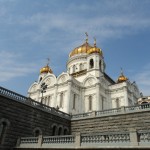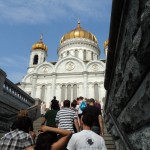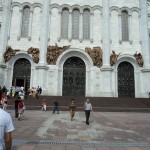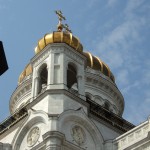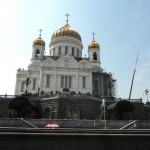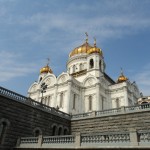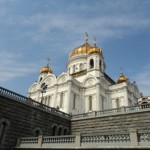 The Cathedral of Christ the Savior in Moscow (Khram Khrista Spasitelia), Russia represents a site which has undergone much change over the past two centuries. Subject to the whims of Russian rulers, both imperial and soviet, both the Cathedral and the land on which it is built have provided not only opportunities for rulers to flex their political muscles and display their wealth but also a lasting reminder of their failures. As of 2010, the only structure meant for that tract of land that has not met with an untimely and politically motivated end is the most recent incarnation of the Cathedral – and that building has stood for less than two decades.
The Cathedral of Christ the Savior in Moscow (Khram Khrista Spasitelia), Russia represents a site which has undergone much change over the past two centuries. Subject to the whims of Russian rulers, both imperial and soviet, both the Cathedral and the land on which it is built have provided not only opportunities for rulers to flex their political muscles and display their wealth but also a lasting reminder of their failures. As of 2010, the only structure meant for that tract of land that has not met with an untimely and politically motivated end is the most recent incarnation of the Cathedral – and that building has stood for less than two decades.
The first Cathedral of Christ the Savior was a physically large and imposing building, although not as large as it was originally intended to be. As with many public memorials (Tsar Alexander I commissioned it as a memorial to the bravery of the Russian people and the grace of God in the Russian victory in the War of 1812), the design of the Cathedral was opened up to a public contest in 1816. The winner of that contest, one Alexander Vitberg, submitted a design which was unprecedented in both its scale and populism. His plan for the cathedral involved a 170 meter above-ground structure, with another 67 meters extending below the ground, a total height of 237 meters. This building would tower over the rest of Moscow, both in its own right, and also on account of the elevated ground of its intended construction site. (Sidorov) The other churches in Moscow, including those within the walls of the Kremlin, were not built on such a grandiose scale. Even the Ivan the Great Bell Tower (Kolokol’nia Ivana Velikogo), formerly the highest point in Moscow, is only 81 meters tall, and that surpasses St. Basil’s. The dome atop the Cathedral would also be 50 meters across, dimensions which surpass those of St Peter’s Basilica in Rome, which has a 42 meter dome, and is “only 141 meters high” (Haskins, 32). But perhaps the most interesting aspect of this design from a site of memory standpoint is Vitberg’s intended method of commemoration. Russia’s strict class system led to a tradition which only commemorated the service or actions of the elites. In his cathedral, dedicated as it was to God and the Russian people, Vitberg intended to inscribe on the walls of the bottom level, which was to be specifically dedicated to “all Russians which had died defending Moscow from Napoleon, from general to foot soldiers” (Hasking, 33), the names of every single soldier who died in the war, not only the officers, and this design was approved by Tsar Alexander I.
Originally, the intended site for the Cathedral was rather distant from the city center, located “on the Vorob’evy Hills… between the two roads Napoleon’s troops used to enter and leave the city” (Sidorov, 554). This version of the Cathedral was never actually built, however, because of the untimely death of Tsar Alexander. His successor, Nicholas I, held a more imperial view of both his position as tsar and the proper method of making the “cathedral-monument… meaningful” (Sidorov, 555). First, he held another design contest in 1829, scrapping Vitberg’s plan entirely. The new winner was Konstantin Ton, whose design better reflected that tsar’s ideology. This design for the cathedral was more Byzantine, more regal, and underlined aggressive nationalism. It was also deemed necessary to find a new location for the Cathedral, one more central to Moscow, and which would connect it more strongly with the state. The various sites that Ton proposed were “already occupied by churches or monasteries”, although this “was probably not a geographical attempt to stress continuity with the ancient past, but rather was a response to the fact that the center of Moscow was already built over” (Sidorov, 556). The selected site ended up being that occupied by The Convent of St. Alexius the Man of God, which was torn down and the sisters relocated to make room for the Cathedral, much to people’s consternation.
The new design was smaller than the original, and other changes included commemoration of the dead from the War of 1812 being limited to officers, reflecting the idea that this new design “venerated the state rather than the individual” (Sidorov, 558, emphasis in the original).
Less than a century later, Stalin ordered the destruction of the cathedral to make way for his Palace of the Soviets, which would be a meeting hall and headquarters for the workers of the world. The Palace’s modernistic design and monumental proportions were an echo of Stalin’s grand plan for the expansion of Communism. The destruction of the Cathedral apparently caused private distress, although under Stalin’s regime it was not publicized. Later, when the idea of Communism shifted to “building Communism in one country”, and because of a lack of funds during and after WWII, the project was abandoned. Later, during the post-Stalin Thaw, the gigantic foundation pit which had marred the landscape was turned into a massive circular heated swimming pool – the largest heated pool in Europe.
The Cathedral was reborn after the fall of the USSR in 1991, when it was decided that there needed to be a commemoration for the victims of Stalin’s terror. A plan was developed to recreate the original Cathedral that stood on the spot a century and a half ago, with an extended underground portion that included a museum, as well as a replacement chapel (and later some housing) for the sisters of the convent which was displaced when the Cathedral was first built. This rebuilding has been more problematic as a site of memory because of issues with methods of commemoration and debate over the appropriateness of state funding, and the wisdom of creating an exact replica of the former Cathedral. The people of Moscow weren’t thrilled, either, at having their pool taken away, but there was no major public opposition to the rebuilding of the Cathedral. Consensus seemed to be that it was an appropriate action, and that the Church deserved that land and a new building.
The rebuilding project was run jointly by the city government of Moscow and the Patriarchate of the Russian Orthodox Church. Both the Mayor and the Patriarch were eager to demonstrate to the people their ability to symbolically affect a reversal of years of Soviet influence over the city and the Church, respectively. The enthusiasm of the Moscow Mayor for the project and his eagerness to have it done as quickly as possible led to some concerns about the ethicality of his methods of obtaining funding. However, the primary concern of most parties was to get the Cathedral finished and have the whole matter swept under the rug, and construction proceeded despite these questions.
When our group of 22 arrived on the Cathedral grounds, we were immediately admonished by a middle-aged Russian woman to be “modest,” (skromnyi) and remember that this was a functioning church. Approaching the building itself, which is set up on a two-story high pedestal above street level, we encountered fewer visitors than I would have expected, although the church was about half full or more once we got inside. The Cathedral was the first church which we had gone to as a group which had turned away any of us because of our clothing. It was not head coverings that kept people from being admitted, but rather shorts, and this rule was applied to both men and women. The contrast of this strictness with the radical nature of the Church’s interior was stark and puzzling.
The new cathedral is roughly divided into three main parts which are open to the public. First, there is the main cathedral, located on the ground floor, which includes in its outer perimeter a recreated memorial to the fallen aristocracy of the War of 1812. On the floor beneath is a smaller church which is surrounded by, but separate from, a museum to the history of the Cathedral and Cathedral site. The main cathedral is decorated in the tradition of the Russian Orthodox Church in terms of layout, content of icons, gilding, and the like, but it also represents a severe and unexpected departure from the traditional Russian Orthodox Church – all the icons are painted in a much more modern and realistic style than traditional icons, with the radical inclusion of perspective. Upon entering the Cathedral, I, more accustomed to the two-dimensional conventions of Orthodox iconography, was completely shocked. This completely unique mode of representation sets the new Cathedral of Christ the Savior apart from Orthodoxy in a way that is unsettling, to say the least. To be unique is not a concept which is looked upon kindly by Orthodoxy in any aspect of religious life, but especially not in the area of icons. The painting of an icon is considered to be an act of prayer, and the formula for icons has been laid out and followed for centuries. For the decorators of the new Cathedral of Christ the Savior to choose this style seems to be indicative of the loss of ingrained religious tradition which occurred during the Soviet Union.
What was also notable about the artistic themes of the Cathedral was that the smaller church in the basement, which was decorated with more traditional iconography, although still with a slightly modern twist, had a higher concentration of people who appeared to actually be praying, rather than merely visiting as tourists. The upstairs church, on the other hand, was filled mostly by tourists, most of whom appeared to be foreign. Some of this may be due to the fact that the stairs to the lower level were a little bit hidden, but the downstairs gift shop was populated enough. The museum, which was also downstairs, was almost completely empty. I walked through the entire circular exhibit twice, and only saw approximately five visitors, one nun, and one woman copying icons. The emptiness of the exhibit suggests a general disinterest in the history of the Cathedral, at least on the part of the out-of-town tourists. But buried deep within the exhibit, there was a small pedestal with a visitor’s book on it which was full of little notes from people thanking the Church (presumably) for rebuilding the Cathedral, and describing what it meant to them. This book suggests that the Cathedral and even the museum are important to a section of the Moscow population as a site of memory, a rebuilding of what was lost during Stalinist times and through the rest of the Soviet Union.
Physically, the Cathedral of Christ the Savior, the Palace of the Soviets, the giant swimming pool, and again the Cathedral of Christ the Savior have all been representative of the Russian love of grand, palatial representations of wealth, power, and belief, whether political, ideological, or religious. Both the first and second Cathedrals show off the resiliency and prosperity of the state. The Palace of the Soviets would have been a symbol of the dramatic and sudden growth of Soviet power and its global possibilities. The history of popular memory and the Cathedral is a convoluted one. As Ekaterina Haskins points out, the Cathedral has always been a building intended for the legitimization of the current regime. As a building intended for the central popular seat of Russian Orthodoxy, the building of the Cathedral became an important political tool. Haskin’s article explores the political and nationalist nature of the Cathedral, and its use as a legitimizing tool (Haskins). Other commentators focus more on the Cathedral as an exercise in “monumentalization” (for example, Sidorov). What I found was a building divided into two distinct parts, the upper level for the state, with its memorial to the War of 1812 and its unconventional iconography – sure to attract visitors and attention, but of little import to the reanimating of the seat of Russian Orthodoxy, and the lower level the clear domain of the church, with a more subdued chapel in which prayers and baptisms were being performed, and a museum which dealt as little as possible with the Soviet period, instead offering detailed plans and diagrams of the old church building, pieces of its marble interior, and pictures and construction helmets from the rebuilding project.
